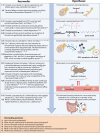Physiological adventures in Candida albicans: farnesol and ubiquinones
- PMID: 38436263
- PMCID: PMC10966945
- DOI: 10.1128/mmbr.00081-22
Physiological adventures in Candida albicans: farnesol and ubiquinones
Abstract
SUMMARYFarnesol was first identified as a quorum-sensing molecule, which blocked the yeast to hyphal transition in Candida albicans, 22 years ago. However, its interactions with Candida biology are surprisingly complex. Exogenous (secreted or supplied) farnesol can also act as a virulence factor during pathogenesis and as a fungicidal agent triggering apoptosis in other competing fungi. Farnesol synthesis is turned off both during anaerobic growth and in opaque cells. Distinctly different cellular responses are observed as exogenous farnesol levels are increased from 0.1 to 100 µM. Reported changes include altered morphology, stress response, pathogenicity, antibiotic sensitivity/resistance, and even cell lysis. Throughout, there has been a dearth of mechanisms associated with these observations, in part due to the absence of accurate measurement of intracellular farnesol levels (Fi). This obstacle has recently been overcome, and the above phenomena can now be viewed in terms of changing Fi levels and the percentage of farnesol secreted. Critically, two aspects of isoprenoid metabolism present in higher organisms are absent in C. albicans and likely in other yeasts. These are pathways for farnesol salvage (converting farnesol to farnesyl pyrophosphate) and farnesylcysteine cleavage, a necessary step in the turnover of farnesylated proteins. Together, these developments suggest a unifying model, whereby high, threshold levels of Fi regulate which target proteins are farnesylated or the extent to which they are farnesylated. Thus, we suggest that the diversity of cellular responses to farnesol reflects the diversity of the proteins that are or are not farnesylated.
Keywords: Candida albicans; farnesol; fungal dimorphism; fusel alcohols; holdase chaperones; mRPMI 1640; protein farnesylation; quorum sensing.
Conflict of interest statement
The authors declare no conflict of interest.
Figures




Similar articles
-
Absence of farnesol salvage in Candida albicans and probably in other fungi.Appl Environ Microbiol. 2024 Jul 24;90(7):e0087424. doi: 10.1128/aem.00874-24. Epub 2024 Jun 28. Appl Environ Microbiol. 2024. PMID: 38940563 Free PMC article.
-
Quantitative assay for farnesol and the aromatic fusel alcohols from the fungus Candida albicans.Appl Microbiol Biotechnol. 2022 Oct;106(19-20):6759-6773. doi: 10.1007/s00253-022-12165-w. Epub 2022 Sep 15. Appl Microbiol Biotechnol. 2022. PMID: 36107213 Free PMC article.
-
Deciphering fungal dimorphism: Farnesol's unanswered questions.Mol Microbiol. 2017 Feb;103(4):567-575. doi: 10.1111/mmi.13601. Epub 2017 Jan 18. Mol Microbiol. 2017. PMID: 27987234
-
Quorum sensing by farnesol revisited.Curr Genet. 2017 Oct;63(5):791-797. doi: 10.1007/s00294-017-0683-x. Epub 2017 Feb 28. Curr Genet. 2017. PMID: 28247023 Review.
-
Cellular interactions of farnesol, a quorum-sensing molecule produced by Candida albicans.Future Microbiol. 2009 Dec;4(10):1353-62. doi: 10.2217/fmb.09.98. Future Microbiol. 2009. PMID: 19995193 Review.
Cited by
-
Absence of farnesol salvage in Candida albicans and probably in other fungi.Appl Environ Microbiol. 2024 Jul 24;90(7):e0087424. doi: 10.1128/aem.00874-24. Epub 2024 Jun 28. Appl Environ Microbiol. 2024. PMID: 38940563 Free PMC article.
-
Regulatory frameworks for fragrance safety in cosmetics: a global overview.Toxicol Res. 2025 Mar 1;41(3):199-220. doi: 10.1007/s43188-025-00283-2. eCollection 2025 May. Toxicol Res. 2025. PMID: 40291114 Review.
-
The Candida albicans quorum-sensing molecule farnesol alters sphingolipid metabolism in human monocyte-derived dendritic cells.mBio. 2024 Aug 14;15(8):e0073224. doi: 10.1128/mbio.00732-24. Epub 2024 Jul 2. mBio. 2024. PMID: 38953353 Free PMC article.
-
The role of serum albumin in Candida albicans filamentation, germ tube formation, and farnesol sequestration.Appl Environ Microbiol. 2024 Dec 18;90(12):e0162624. doi: 10.1128/aem.01626-24. Epub 2024 Nov 11. Appl Environ Microbiol. 2024. PMID: 39526801 Free PMC article.
References
-
- Nickerson KW, Atkin AL. 2017. Deciphering fungal dimorphism: farnesol’s unanswered questions: deciphering fungal dimorphism. Mol Microbiol 103:567–575. - PubMed
Publication types
MeSH terms
Substances
Grants and funding
LinkOut - more resources
Full Text Sources

